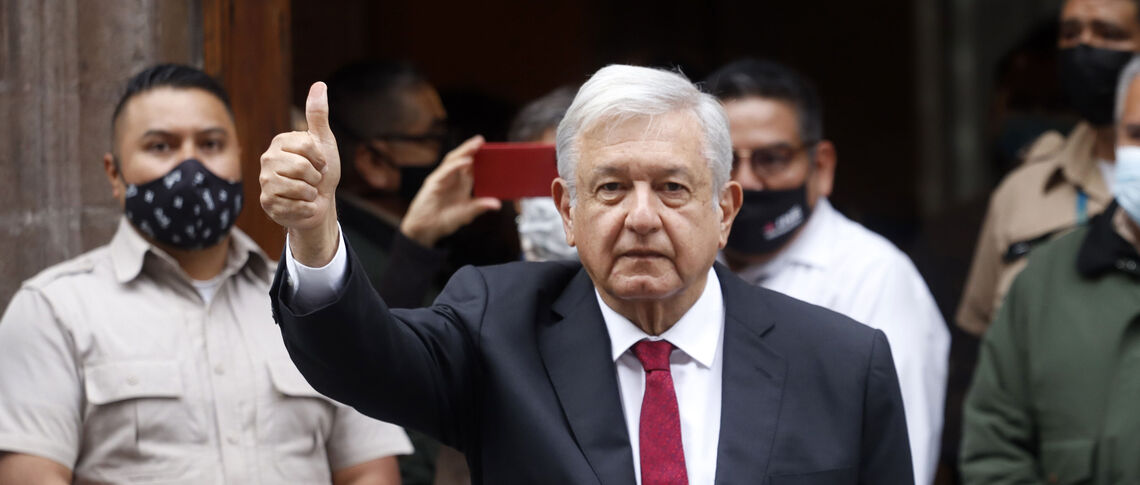These elections were extremely violent: at least 89 politicians were murdered in the run-up to Mexico’s recent parliamentary and regional elections. In total, there were nearly 800 attacks, most of them at the local level. At the same time, 99 judicial and administrative officials had been killed by the end of May, as reported by the non-governmental organisation Etellekt.
Large parts of Mexico are controlled by organised crime, and the judiciary is hardly willing or able to solve the numerous crimes. Politicians can hardly be protected by the state. On the contrary, organised crime functions under the protection of the state. The financing of political parties, election campaigns and the political system are part of the criminal business model. According to a report by the team of specialist Edgardo Buscaglia, between 70 and 90 per cent of the funds for election campaigns come from illegal sources.
The situation is similar in public administration – access to contracts and state-owned companies is bought, and bogus companies are protected. In this environment of general illegality, according to Buscaglia, Mexican politics has turned into an enormous source of self-enrichment, and generates organised state crime this way. But it is not only organised crime that is behind the violence. Violence is a political tool for all sorts of legal or illegal, private or public actors, used by companies (in informal employment relationships), caciques or local officials.
A weakened government – with a weak opposition
The incumbent president, Andrés Manuel Lopez Obrador, or AMLO for short, took office in 2019 with the promise to curb this rampant violence and impunity. So far he has not yet succeeded in doing so. But, as the outcome of last weekend’s elections showed, the people do not seem to hold this against him. This was not a presidential election and yet it was primarily a way to test the waters for President Lopez Obrador.
Despite the losses in the Chamber of Deputies, the election results represent an endorsement of the president, especially at the regional level.
The president has been in office for two and a half years. The Movimiento Regeneración Nacional (Morena) party he founded has now lost its absolute majority in parliament, although with 40 per cent of the seats, it remains by far the strongest party. In future, however, the governing coalition will have to negotiate constitutional amendments with the opposition in both the Chamber of Deputies and the Senate. The government will also have to negotiate more with its allies within the coalition.
The opposition made up of the former governing parties Partido Acción Nacional (PAN) and Partido Revolucionario Institucional (PRI), which had been weakened in the 2018 elections, as well as the Partido de la Revolución Democrática (PRD), had come together in a coalition of former rivals to jointly prevent the governing coalition from winning another qualified majority. They succeeded. At the same time, they did not succeed in polishing up their poor reputation. Merely working off the president did not go down well with the electorate.
AMLO’s leftist conservatism
Despite the losses in the Chamber of Deputies, the election results represent an endorsement of the president, especially at the regional level. His party’s candidates won most of the gubernatorial elections in the country. This success of the ruling party is quite astonishing considering the situation in the country. Officially, almost 230,000 people have died of Covid-19 in Mexico so far. However, the excess mortality rate is much higher; official statistics indicate that as many as 340,000 people had died by mid-March as a result of the virus infection. This would be significantly more than even Brazil.
The economic slump of minus 8.5 per cent in 2020 was the most severe in the last 90 years. Around five million people have lost their jobs, and one out of five companies was forced to close. Since the outbreak of the pandemic, reduced incomes have temporarily pushed 13 million people below the poverty line. At any other time, such a crisis would have had a strong negative impact on the popularity of the president and the parties supporting him.
The fact that the government has largely confined distributional questions to transfer payments; that fiscal reform is not up for debate; that austerity policies are being promoted even in the pandemic; that the development of a welfare state, inclusive growth, environmental and climate protection and other progressive reforms are not part of the program; that there has been no progress in combating widespread impunity and institutional corruption; that the militarisation of public security is moving forward – all of these are signs, in the eyes of left-wing critics, that the president has abandoned the left, and perhaps even the democratic camp. From the conservative camp, in turn, he is being attacked for his state-centeredness and interference in the economy as well as his socio-political populism. In any case, AMLO, who is probably best described as a conservative leftist, provides enough targets.
An effective populist
For the majority of the population, despite all these shortcomings, AMLO is the president needed to bring about the necessary changes. In their eyes, his government is on the right track. The criticism does not carry much weight: whether it is the accusation of populism, his specific mistakes in the pandemic, the inadequate handling of the economic crisis and its social consequences, the desolate situation of public security – nothing seems to really stick. In various surveys in May, AMLO’s popularity ratings averaged 61 per cent. Only one third of those surveyed were dissatisfied with his government.
For many, the president is a shining light; for others, despite doubts, he is the only realistic chance for change.
The president’s public demeanour and credibility play a major role in this positive assessment. AMLO’s political actions have always been characterised by the fight against poverty and privilege. Inequality and marginalisation were and are at the centre of his discourse. In the past, the non-privileged had little or nothing to expect from the state; he is now making an offer to them to put this state in the service of the majority. Increased tax collection from large companies, social programmes, the reform of labour law and the trade union system, the regulation of temporary work, the increase in the minimum wage, the introduction of a basic pension and the planned reform of the private pension system – all these speak in favour of the government.
The president is also omnipresent. At every opportunity, especially at his daily morning press conferences, he polarises, attacks his opponents, raises allegations of corruption and also oversteps the bounds of the separation of powers. The government has also been accused of having undermined freedom of the press in various cases. Despite all the attacks against the institutions, especially against the electoral authority, in the end he has so far always accepted their decisions. At the same time, this way he succeeds in occupying the political agenda. In doing so, he makes use of the populist scheme of the struggle of the representatives of the people against the corrupt representatives of power.
For many, the president is a shining light; for others, despite doubts, he is the only realistic chance for change. Together these two camps make up the majority. His discourse has so far immunised him from criticism in the eyes of these people. In turn, his criticism of the conservative elites jibes with the concrete experiences of a large part of the population. The majority of the population continues to see AMLO as an opportunity. The president draws his persuasive power primarily from politics for the few that has been common practice in the past.






